There’s no excuse not to find a Tallow Plum.
Other than citrus I don’t think there’s anything else right now growing bright yellow, pingpong-ball size fruit. I do think you’ll have an easier time finding them in coastal communities than center of the state but they grow in both places. I’ve seen them in Wickham Park, Melbourne; Enchanted Forest, Titusville; Haulover Canal, Kennedy Space Center; and Red Bug Slough in Sarasota. They’re a dark green, gangly shrub fond of sandy soil and low growing oaks and scrub pine. A mesic hammock is a good place to start. For you locals who’d like to see them they are just northwest of the Enchanted Forest building, follow the dirt trail, sand dunes on your left. At Haulover canal they are a common shrub southwest and southeast of the bridge on the old service roads. In Sarasota they are 120 feet southwest of the bathrooms. Wickham Park has quite a few on the road that leads from the east bathrooms to the east soccer field, between the stream and the fork in the road, mostly on the south side. The state of Florida says they grow in the middle of the state but it took me decades to find one and I note it is not fruiting yet.
I am often asked where to forage. Fair enough question, but it’s also reasonable to ask where not to forage. One answer in Central Florida is Rolling Hills Golf Course.
Often out-of-business golf courses can be excellent places to forage, especially if they are new and didn’t stay in business long. There is one a few miles away and it’s a great place to find weeds. The key, however, was it was not in business long. It was built recently and went out of business in just a few years. Old golf courses are a different matter. Near here is Rolling Hills Golf Course. Built in 1926 it was in operation before there were neighborhoods now around it. I never golfed there (or anywhere) and never foraged there. But I did attend a few social events at the golf course over the decades. The business went belly up three years ago. I can remember driving by it this spring a marveling at how the weeds were taking over the greens. However….
The county agreed to buy the property to make a 100-acre community park, for $3.9 million and sell off 20 acres for housing. Part of the agreement was the understanding the land had to be cleaned up a little. Estimates now say that the clean up will cost more than $1 million because of all the arsenic and dieldrin insecticide contamination. Dieldrin was an alternative to DDT and used widely from the 1950s to the early1970’s. It was discontinued except for use against for termites up until 1987. It does not break down easily, is passed along the food chain, and is now banned in most of the world. Deidrin has been linked to a lot of health issues in humans. Once ingested it can be stored in fat cells and take years to leave the body. Dieldrin is found in most watersheds with the majority of it attached to soil at the bottom of lakes, ponds, and streams. The weeds now where the greens used to be at Rolling Hills should be avoided especially water edibles.
Mushrooms can be part of foraging but they are often way down the list for most Americans. The process is usually green plants then tress followed by grasses. Then the brave tackle mushrooms last. Unlike Europe where mushroom hunting is a passion Americans inherited the British disdain for the activity. It also doesn’t help that every decade or so someone who knows mushrooms dies from eating them. This is why one should stick to the half dozen or so easy to identify ones with non-deadly look alikes.
Happily responding to recent rains are chanterelles. They’re fairly easy to find, have only one common mushroom they could be confused with, and are quite tasty. Commonly found under oaks — at least all the ones I’ve ever found have been under oaks — they range in color from egg yoke yellow to pinkish red. The stems when cut are usually white inside, or lighter than the outside, and they do not have gills. Instead of gills chanterelles have wrinkles that fork and split and occasionally crisscross. Many when freshly picked have a slight apricot odor. Chanterelles also tend to be solitary or just a few together. Their mildly toxic look-alike, Jack O’ Lanterns, are very colonial.
“Jacks” grow on wood, are usually much larger, have true gills not wrinkles, and are the same color on the inside of the stem as on the outside. And the gills of a fresh Jack O; Lantern will have a faint glow in the dark, like the old watches used to have. This is why Omphalotus illudens are called Jack O’Lanterns. We have at least four different kinds of mushrooms locally that are easy to identify and don’t have bad look-alikes with lasting affects.
Hands-on Foraging Classes:
Wednesday, August 9th, Senior Stroll, meet in front of Panera’s, north end, 329 N. Park Avenue, Winter Park. We will wander around Winter Park for to or three hours looking at edibles. Mid-week rate $20 (non-seniors welcome.) Later start time: 10 a.m.
Saturday, August 12th, Blanchard Park, 10501 Jay Blanchard Trail, Orlando, FL 32817. 9 a.m.
Sunday, August 13th, Jervey Gantt Recreation Complex, 2390 SE 36th Ave, Ocala, FL, 34471. 9 a.m.
Saturday, August 19th, Spruce Creek Park, 6250 Ridgewood Ave. Port Orange, 32127. 9 a.m.
Sunday, August 20th, Dreher Park, 1200 Southern Blvd., West Palm Beach, 33405, 9 a.m.
For more information about the classes go here.
All of Green Deane’s videos available for free on You Tube. They do have ads on them so every time you watch a Green Deane video I get a quarter of one cent. Four views, one cent. Not exactly a large money-maker but it helps pays for this newsletter. If you want to see the videos without ads and some in slightly better quality you can order the DVD set. It is nine DVDs with 15 videos on each. Many people want their own copy of the videos or they have a slow service and its easier to order then to watch them on-line. They make a good gift for that forager you know. Individual DVDs can also be ordered. You can order them by clicking on the button on the top right of this page or you can go here.
Want to identify a plant? Looking for a foraging reference? Do you have a UFO, an Unidentified Flowering Object you want identified? On the Green Deane Forum we chat about foraging all year. And it’s not just about warm-weather plants or just North American flora. Many nations around the world share common weeds so there’s a lot to talk about. There’s also more than weeds. The reference section has information for foraging around the world. There are also articles on food preservation, and forgotten skills from making bows to fermenting food. One special section is “From the Frightening Mail Bag” where we learn from people’s mistakes. You can join the forum by clicking on the button on the upper right hand side of this page.
While on the theme of yellow fruit, but much smaller than the Tallow Plum, we should mention Ground Cherries. This past week in Melbourne we found many ripe and ready for eating. I have a suspicious that in rainy years they tend to be sweet and in drier years more often bitter. I always taste one and wait a minute or so to see if any bitterness is revealed. The ones we had we golden and quite sweet. More so there were several of them rather than just one here or there. Ground Cherries are related to tomatillos and tomatoes. And like tomatoes the will ripen off the plant but won’t grow sweeter. These low-growing plants don’t like to compete with lawns or trees. I usually find them in transition zones such fields to shrubs. To read more about Ground Cherries go here.
This is issue 269.
If you would like to donate to Eat The Weeds please click here.

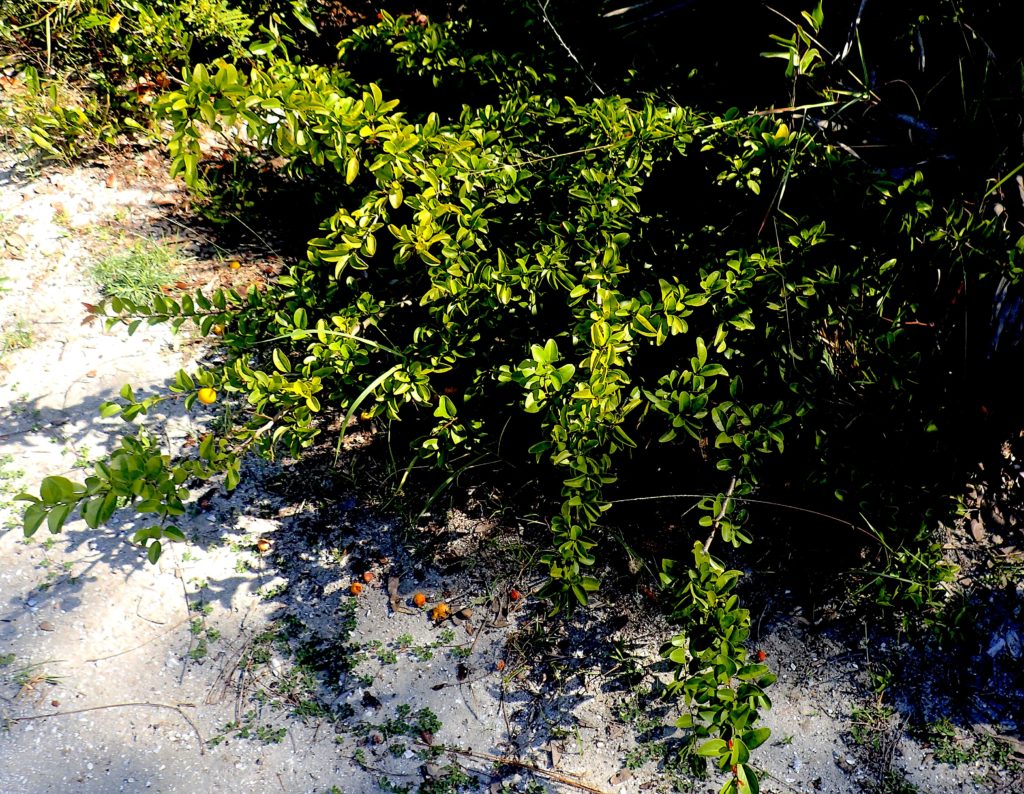
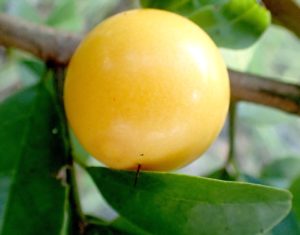
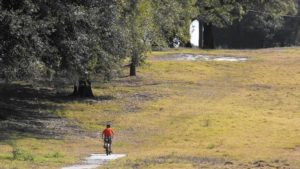


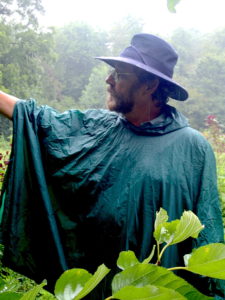


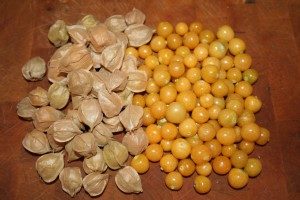

Thank you for your consistent hard work. My children and I have learned a great deal from you over the years.
Citrous, bright yellow, slightly bigger than pingpong – size: yes almost a dozen I collect every morning these days; but instead of Tallow plums, they are so ripe lemon fruits that could no longer withstand the strong mid – night wind of the present rainy season.How generous is my citrous tree: I can see a new generation of blossoms coming.lndeed it is kind for us and much kind for bees which are now being attracted intensively after a long period of abscence. Buterflies are also hovering – happy days are these days for all here.
Found several Tallow Plum bushes on Tiger Lake Rd., Lake Wales (about 1/2 mile west of La Llanada). They are growing wild among hammock trees and shrubs. Cannot get any more “central” in Florida than here.